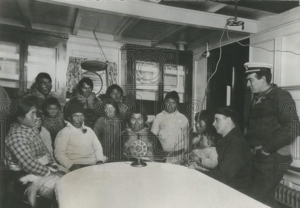Experiments
The Sitz Meter
Shown is Robert E. Lewis, a physicist at the Armour Research Foundation, circa 1950, who's experimenting with his "sitz" meter, a device designed to measure chair comfort. Weight sensors on the pads of the chair would turn on corresponding lights on the panels on the wall, showing how the person in the chair (Judy Blumenthal, who looks thrilled to be participating in the experiment) was distributing their weight. Lewis was trying to scientifically design a more comfortable chair.
Posted By: Alex - Tue Oct 01, 2013 -
Comments (7)
Category: Science, Experiments, 1950s
Become a Cow
Stanford researchers are using virtual reality gear to allow volunteers to experience what it feels like to be a cow. They're curious about whether the experience of temporarily "becoming" a cow will reduce people's desire to eat cows. If the video below doesn't work, the article is here.
Posted By: Alex - Wed Aug 21, 2013 -
Comments (6)
Category: Science, Experiments, Cows
Lose Your Head If It Wasn’t Attached
Head transplants , according to Italian surgeon Dr. Sergio Canavero, are possible. Not in the future, but right now he claims. It has been attempted on animals in the past but total paralysis was an insurmountable problem. The doctor says spinal cord repair is possible today. The proceedure is estimated to require 100 surgeons 36 hours at the cost of 8.5 million British pounds. I doubt NHS or Obamacare will ever cover it though.
Posted By: Alex - Sat Jul 06, 2013 -
Comments (4)
Category: Experiments
“The Blob” Shipped To Your Home
If you haven't seen "The Blob", you need to watch that classic sci-fi horror film. For the uninitiated, watch this magic putty absorb magnets. It's not the same as "The Blob" oozing into the movie theatre through the air vents, but who could predict you could have this in your own home?Magnetic Putty Magic (Extended Cut) | Shanks FX | PBS Digital Studios from Joey Shanks on Vimeo.
I've also included the preview to "The Blob". Don't forget to listen to the snappy tunes at the end.
Here's the link to buy some magnetic putty of your own!!
http://www.puttyworld.com/midnightcolors.html
Posted By: gdanea - Wed Jul 03, 2013 -
Comments (2)
Category: Experiments
Jet Bike—Pulse Engine
Colin Furze is a certifiable maniac. Not only has he driven a baby carriage 50 MPH, he modified an old bicycle with a pulse engine.Here's a link to the baby carriage exploit.
http://gizmodo.com/a-jet-powered-fire-blowing-bicycle-is-not-ridiculous-a-513022184
I expect we will be reading his obituary someday soon, which will include his crazy exploits.
Posted By: gdanea - Wed Jun 12, 2013 -
Comments (10)
Category: Experiments
Hidden Messages from the Universe in Resonance Experiment
You may have seen resonance experiments before, but I secretly believe the results of this experiment are the secret code of the universe.Watch the whole thing -- there are some amazingly beautiful patterns.
Once we figure out the alphabet of the mysteries, then we probably find the ultimate answer isn't 43, but 4444 -- see the results at about 2:36.
It has to mean something. -- if you squint it looks like a Star Wars Storm Trooper helmet.
Posted By: gdanea - Fri Jun 07, 2013 -
Comments (3)
Category: Experiments
Cool Way To Detect Cosmic Neutrinos In IceCube
Want to find neutrinos from the cosmic Big Bang? Get ice cold. This subterranean telescope can catch cosmic neutrinos.
Here's the link, which also includes a photo of the hot water drill they used to get 2450 meters deep:
http://gizmodo.com/this-subterranean-telescope-may-have-just-seen-humanit-507516289
I know it cost $279 million, but that seems really cheap compared to lots of other things we spend money on, and it's way bigger than the Eiffel Tower, as the illustration shows. "Bert" and "Ernie" are the names of the first two cosmic neutrinos they think have been discovered.
IceCube. Not just a rapper or a way to cool your drink. Discovering the Big Bang one Sesame Street Character at a time. (Or for the older folks, the taxi-driver and the cop from "It's a Wonderful Life.)
Posted By: gdanea - Thu May 16, 2013 -
Comments (2)
Category: Experiments
Earthquake-Predicting Dogs
Over in China, researchers decided to test the theory that dogs can predict earthquakes. So they housed four dogs at the Nanchang quake center and waited for them to show signs of "abnormal" activity, such as barking a lot.They soon discovered that dogs (and apparently these dogs in particular) often bark a lot. According to local residents "every night at 11pm they start barking over and over." After fielding multiple complaints from angry neighbors, the researchers "offered to muzzle the dogs, but accepted later that this might impede their skills as quake-prognosticators." Finally, the experiment was shut down.
So maybe dogs can predict earthquakes, or maybe they can't. But until we learn to speak dog language better, it doesn't look like our canine friends will be much use to us as official quake predictors. [London Times]
Posted By: Alex - Fri May 10, 2013 -
Comments (4)
Category: Science, Experiments, Dogs
Singing Eskimos

In the picture, MacMillan is second from right. The guy standing behind him is Eugene McDonald, founder of Zenith Radio Corporation. His company built the special short wave radio gear used on the expedition. All others in the picture are the singing eskimos.
Posted By: Alex - Tue Apr 30, 2013 -
Comments (3)
Category: Music, Radio, Experiments, 1920s
Please Poop, Mr. Cow!
Although modern science has been able to send a man to the moon, it has not been able to make cows poop on command. An effort to solve this shortcoming is described in a recent issue of Applied Animal Behaviour Science.The thing is, it would be really nice, for the purpose of general hygiene, if farmers could convince cows to stop pooping wherever they felt like it. So researchers devised a series of tests to see if prompts such as walking through a footbath, or being exposed to blasts of air or water, could stimulate bovine defecation. No such luck. The researchers concluded, "None of our tests reliably stimulated defecation, which seemed to occur most when cows were exposed to novelty."

Posted By: Alex - Sun Feb 17, 2013 -
Comments (7)
Category: Science, Experiments, Farming, Cows, Excrement

| Who We Are |
|---|
| Alex Boese Alex is the creator and curator of the Museum of Hoaxes. He's also the author of various weird, non-fiction, science-themed books such as Elephants on Acid and Psychedelic Apes. Paul Di Filippo Paul has been paid to put weird ideas into fictional form for over thirty years, in his career as a noted science fiction writer. He has recently begun blogging on many curious topics with three fellow writers at The Inferior 4+1. Contact Us |




